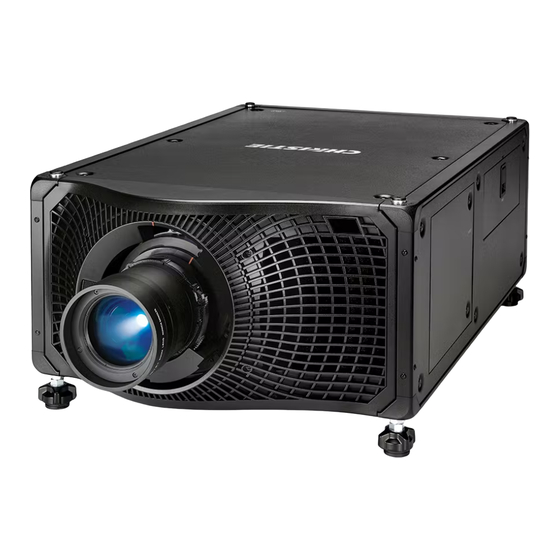Table of Contents
Advertisement
Quick Links
Advertisement
Table of Contents

Summarization of Contents
Introduction
Safety and Warning Guidelines
General safety warnings, operating environment, lens, electrical, and moving part hazards.
Light Intensity Hazard Distance
Information on optical and thermal radiation hazards and required safe distances.
Product Labels and Hazards
Explains product labels and general, fire, shock, and electrical hazards.
Electrical and Additional Hazard Labels
Describes electrical labels and additional hazard labels found on the projector.
Projector Overview
Provides a general description of the Mirage 304K projector's technology and capabilities.
Contact Your Dealer
Instructions on how to contact a dealer for service and product information.
Ethernet Settings
Configuration options for network settings like IP address and subnet mask.
Key Features
Highlights the main features and capabilities of the Mirage 304K projector.
How the Projector Works
Explains the internal technology and operational process of the projector.
List of Components
Lists the main components included with the projector package.
Product Documentation
Information on accessing installation, setup, and user guides for the projector.
Site Requirements
Minimum requirements for the installation location to ensure safe operation.
Physical Operating Environment
Specifies ambient temperature, humidity, and altitude requirements.
Power Connection
Details the dual AC inlet power system and connection requirements.
Projector Components
Identifies the main components of the projector with a diagram and table.
IR Remote Keypad Operation
Explains the functionality, buttons, and operation of the infrared remote control.
Display Panel Components
Identifies and explains the components of the projector's display panel.
Turning On the Projector
Step-by-step guide on how to power on the projector.
Projector LED Status Indicators
Explains the meaning of different LED colors and states for status indication.
Projector LED Shutter Indicators
Explains the LED states for the projector's shutter status.
Turning Off the Projector
Instructions for safely powering down and disconnecting the projector.
Adjusting the Image
Screen Image Orientation and Resizing
Sets image orientation and configures image resizing presets.
Lens Settings and Adjustments
Covers adjustments for lens offset, zoom, focus, and motor locking.
Lens Control Limitations
Illustrates keep-out areas for lens position to prevent interference or damage.
Color Adjustments
Covers primary colors, DMD, chromaticity, saturation, color space, temperature, gamma.
Image Processing and Enhancement
Covers frame delay, film mode detection, sharpness, and edge blending.
Geometry and Keystone Correction
Covers geometry correction, warping, keystone adjustments, and pixel cropping.
Configuring System Settings
Date, Time, and Splash Screen
Configures the projector's date, time, and splash screen background color.
Display and Language Settings
Sets on-screen display position, language, and temperature units.
User Account and Power Settings
Manages user passwords, power interruption resume, and standby electronics.
Input Signal and HFR Configuration
Configures video pass-through, DVI receivers, EDID, and high frame rate.
Lamp and Power Management
Adjusts lamp power, selects lamps using BrightSelect, and enables low voltage startup.
Implementing Stealth Mode
Disables status LEDs and heartbeat feature for stealthier operation.
Configuring Communications
Projector Communication and Access Levels
Enables projector communication and sets remote access levels.
Art-Net Network Configuration
Sets up projector communication using Art-NET over Ethernet.
Input Channel Index
Provides an index of input channel numbers and their descriptions.
Macros and GPIO Automation
Automates tasks using Scheduled Event and GPIO Event macros.
GPIO Connector Details
Describes the D-Sub GPIO connector, pins, signals, and output.
Projector Profiles
Creating, Importing, and Restoring Profiles
Saves, loads, and reverts projector settings using profiles.
Renaming, Exporting, and Deleting Profiles
Manages projector profiles by renaming, exporting, or deleting them.
Software and File Management
Software Upgrades and Licensing
Installs new software versions and adds software licenses to the projector.
Backup and Restore Operations
Exports projector settings for backup and imports them to restore.
Restoring Projector Defaults
Resets all customized settings to the projector's factory default values.
Diagnostic Tools
System Information and Lamp Status
Views projector information, licenses, and lamp status/hours.
Test Patterns and Modification
Selects and modifies characteristics of various test patterns.
System Status and Monitoring
Views projector status, monitors with Christie TAP, and runs interrogator.
SNMP and Trap Configuration
Configures SNMP settings, traps, and IP addresses for alerts.
Restoring Factory Default Settings
Resets all device settings to factory defaults, excluding network configuration.
Mirage 304K Specifications
Display and Control Specifications
Details display resolution, contrast, color, white point, and control interfaces.
Sync, Input, and Port Specifications
Details 3D sync, RS232, GPIO, wired remote, and shipped input cards.
Optional Cards and Sensor Thresholds
Lists optional input cards and temperature sensor warning/error thresholds.
Fan and Power Requirements
Details fan warning thresholds and projector power requirements.
Physical, Accessory, and Regulatory Details
Provides physical specs, accessories, regulatory conformance, and safety standards.
Environmental and EMC Compliance
Covers NFC reader, EMC, and environmental regulations (RoHS, WEEE).
Operating Environment Requirements
Specifies temperature, humidity, and altitude requirements for operation.
Signal Connectivity Specifications
HBMIC, DP 1.2, and HDMI 2.0 Formats
Lists HBMIC video formats for DisplayPort 1.2 and HDMI 2.0.
3D, SDI, QDPIC, and TDPIC Formats
Details video formats for 3D, SDI, QDPIC, and TDPIC signals.
DDIC, THIC, HDBase-T, and 3GIC Formats
Lists video formats for DDIC, THIC, HDBase-T, and 3GIC signals.
Advanced 3D Connectivity
Details dual-input 3D formats and HBMIC/QDPIC/TDPIC for 3D signals.











Need help?
Do you have a question about the Boxer 2K20 and is the answer not in the manual?
Questions and answers